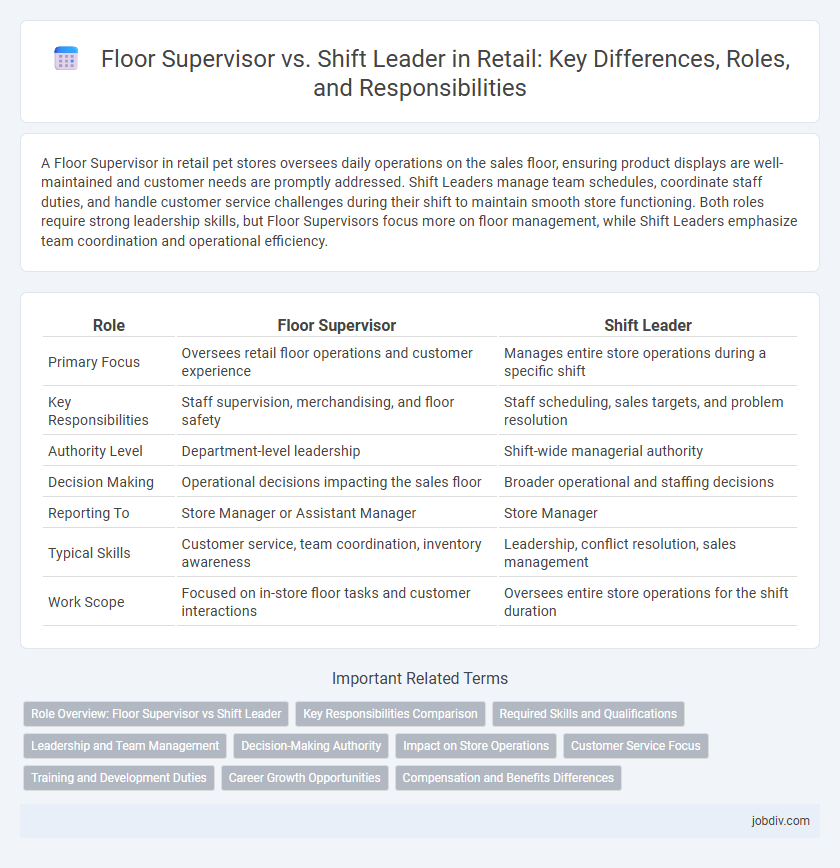A Floor Supervisor in retail pet stores oversees daily operations on the sales floor, ensuring product displays are well-maintained and customer needs are promptly addressed. Shift Leaders manage team schedules, coordinate staff duties, and handle customer service challenges during their shift to maintain smooth store functioning. Both roles require strong leadership skills, but Floor Supervisors focus more on floor management, while Shift Leaders emphasize team coordination and operational efficiency.
Table of Comparison
| Role | Floor Supervisor | Shift Leader |
|---|---|---|
| Primary Focus | Oversees retail floor operations and customer experience | Manages entire store operations during a specific shift |
| Key Responsibilities | Staff supervision, merchandising, and floor safety | Staff scheduling, sales targets, and problem resolution |
| Authority Level | Department-level leadership | Shift-wide managerial authority |
| Decision Making | Operational decisions impacting the sales floor | Broader operational and staffing decisions |
| Reporting To | Store Manager or Assistant Manager | Store Manager |
| Typical Skills | Customer service, team coordination, inventory awareness | Leadership, conflict resolution, sales management |
| Work Scope | Focused on in-store floor tasks and customer interactions | Oversees entire store operations for the shift duration |
Role Overview: Floor Supervisor vs Shift Leader
A Floor Supervisor in retail manages daily operations on the sales floor, ensuring merchandise presentation, staff performance, and customer service quality meet company standards. A Shift Leader oversees employee workflows during a specific shift, focusing on task delegation, time management, and resolving immediate operational challenges. Both roles require leadership skills, but the Floor Supervisor holds broader responsibility for overall floor performance, while the Shift Leader concentrates on shift-specific team coordination.
Key Responsibilities Comparison
A Floor Supervisor manages the overall store environment, ensuring product displays, customer service standards, and inventory control are maintained, while a Shift Leader primarily focuses on operational tasks during their shift, including staff coordination, task delegation, and resolving immediate customer issues. Floor Supervisors typically oversee broader strategic responsibilities such as training and performance evaluations, whereas Shift Leaders emphasize real-time team management and workflow efficiency. Both roles require strong leadership skills, but the Floor Supervisor holds greater accountability for store ambiance and long-term operational success.
Required Skills and Qualifications
Floor Supervisors in retail must possess strong organizational skills, expertise in customer service, and the ability to manage inventory efficiently, typically requiring a high school diploma and experience in retail operations. Shift Leaders need excellent leadership abilities, problem-solving skills, and proficiency in employee scheduling, often demanding prior supervisory experience and knowledge of retail sales strategies. Both roles benefit from communication skills, adaptability, and familiarity with point-of-sale systems to ensure smooth store operations.
Leadership and Team Management
Floor Supervisors oversee daily retail operations by managing team workflows, ensuring customer satisfaction, and maintaining merchandise standards, emphasizing leadership through hands-on guidance and problem-solving. Shift Leaders focus on directing staff during specific shifts, prioritizing real-time team coordination, task delegation, and performance monitoring to maintain operational efficiency. Both roles require strong leadership and team management skills, with Floor Supervisors holding broader operational responsibilities and Shift Leaders concentrating on shift-specific team dynamics.
Decision-Making Authority
Floor Supervisors typically hold greater decision-making authority than Shift Leaders, managing overall store operations and handling escalated customer issues. Shift Leaders primarily focus on supervising team members during a specific shift and making immediate operational decisions within that timeframe. The Floor Supervisor often sets policies and enforces store standards, while Shift Leaders execute these directives and address real-time challenges.
Impact on Store Operations
A Floor Supervisor directly manages floor staff and customer interactions, ensuring product displays are optimized and sales goals are met, which enhances overall store efficiency and customer satisfaction. A Shift Leader oversees the entire shift's operations, including inventory control, staff scheduling, and resolving escalated issues, maintaining smooth workflow and minimizing downtime. Both roles drive store performance but the Shift Leader has broader responsibilities impacting operational continuity and team coordination across shifts.
Customer Service Focus
A Floor Supervisor in retail ensures seamless customer service by monitoring staff interactions and addressing escalated customer concerns to maintain satisfaction levels. Shift Leaders manage daily operations while supporting team members in delivering prompt, personalized service to enhance the shopping experience. Both roles prioritize customer engagement but differ in scope, with Floor Supervisors focusing on overall floor performance and Shift Leaders emphasizing frontline team leadership.
Training and Development Duties
Floor Supervisors oversee comprehensive training programs, ensuring team members master customer service protocols and product knowledge. Shift Leaders focus on hands-on coaching during shifts, addressing immediate performance feedback and skill enhancement. Both roles prioritize employee growth but differ in scope and timing of developmental responsibilities.
Career Growth Opportunities
Floor Supervisors often manage daily store operations and direct associate activities, providing a foundational leadership role that sharpens staff management and problem-solving skills. Shift Leaders typically bear broader responsibilities including overseeing entire shifts, managing sales targets, and ensuring customer satisfaction, which builds strategic decision-making and operational oversight experience. Both roles offer distinct career growth paths, with Floor Supervisors progressing towards department management and Shift Leaders advancing to store management or regional leadership positions in retail.
Compensation and Benefits Differences
Floor Supervisors in retail typically earn higher base salaries compared to Shift Leaders, reflecting their broader management responsibilities and oversight duties across the sales floor. While Shift Leaders often receive standard hourly wages, Floor Supervisors may benefit from additional compensation incentives such as performance bonuses, profit-sharing programs, and enhanced healthcare packages. Benefits for Floor Supervisors usually include extended paid time off and retirement savings plans, highlighting a compensation structure designed to attract and retain mid-level management talent.
Floor Supervisor vs Shift Leader Infographic

 jobdiv.com
jobdiv.com